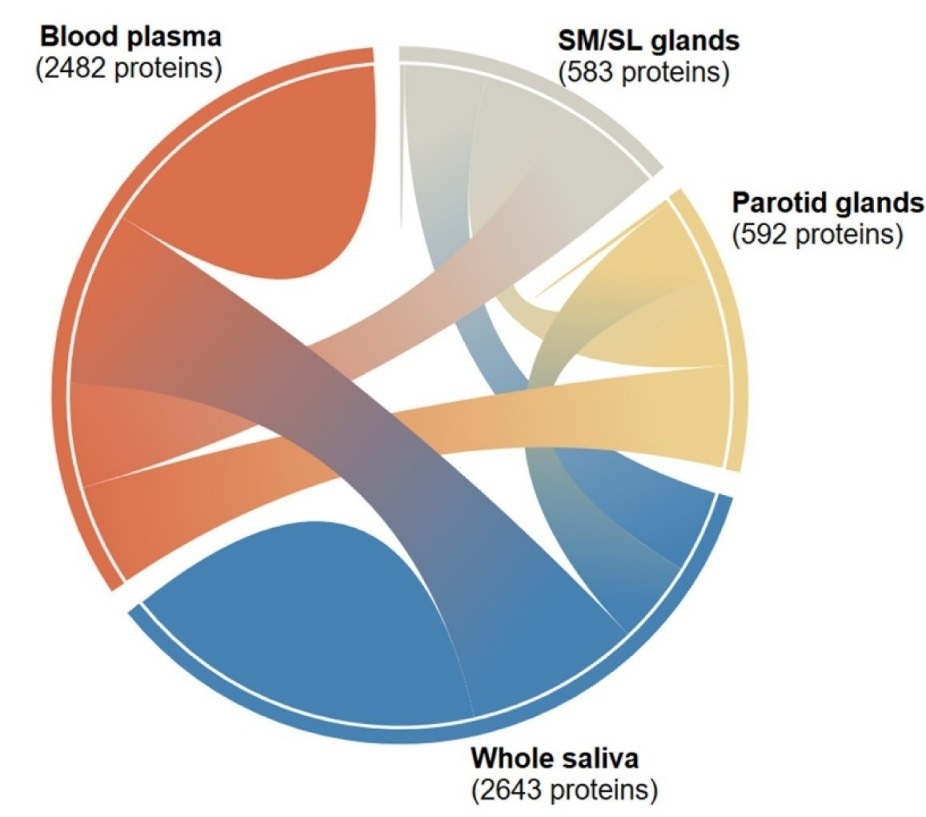The National Institute of Dental and Craniofacial Research (NIDCR) has funded the creation of the Human Salivary Proteome Wiki, the first public platform that organizes and curates information on each of the thousands of proteins found in the human saliva, to promote the development of innovative saliva-based diagnostic tests and customized treatment.

A diagram that shows the interconnectedness of the thousands of salivary proteins originating from blood plasma, parotid glands, and submandibular and sublingual glands. The diagram is one of many tools available to researchers and clinicians through the Human Salivary Proteome Wiki. Image Credit: National Institute of Dental and Craniofacial Research.
The wiki, as described in an article published in the Journal of Dental Research, offers researchers and clinicians with rich, impartial information from numerous independent studies to help them investigate the complex and dynamic nature of saliva, as well as analytical tools to search for data by illness, tissue type, and other criteria.
This community-based data and knowledge base will pave the way to harness the full potential of the salivary proteome for diagnosis, risk prediction, and therapy for oral and systemic diseases, and increase preparedness for future emerging diseases and pandemics.”
Stefan Ruhl, DDS, PhD, Study Lead Investigator and Curator, Human Salivary Proteome Wiki
Ruhl is also an oral biology professor at the University of Buffalo School of Dental Medicine. Saliva aids speaking, swallowing, taste, digestion, and acts as the body’s first line of defense against infections in the mouth, protecting it from dangerous microorganisms.
Saliva’s significance in immunological responses, as well as its simplicity of collection as a fluid sample, make it an appealing tool in noninvasive diagnostic and precision medicine. It was frequently utilized during the COVID-19 pandemic to identify the virus and track the body’s immunological response.
The enormous amount of variety in the hundreds of salivary proteins, however, poses a barrier in saliva research. As a result, typical ranges for the composition of saliva must be defined to characterize the state of health, according to Ruhl, who co-authored research in 2020 on how saliva is formed, tracing the origins of proteins in human saliva back to their sources.
Saliva has become an attractive body fluid for on-site, remote and real-time monitoring of oral and systemic health. The scientific community needs a saliva-centered information platform that keeps pace with the rapid accumulation of new data and knowledge.”
William Lau, PhD, Study First Author, National Institutes of Health (NIH)
“The Human Salivary Proteome Wiki will improve salivary sciences, saliva-based diagnostics, precision medicine, and dentistry, and ultimately facilitate personalized treatment for both oral and systemic diseases,” said Preethi Chander, Ph.D., program director of the NIDCR Salivary Biology and Immunology Program.
Modernized to “harness the full potential of the salivary proteome”
The Human Salivary Proteome Wiki, funded by NIDCR and created in partnership with the NIH Center for Information Technology, was launched in 2019 as a user-friendly public database to provide rich analytical, curation, and annotation capabilities for the biomedical research community.
The database collects data and studies on the salivary proteome, genome, transcriptome (mRNA types and amounts expressed in salivary gland tissue), and glycome (array of sugars attached to salivary glycoproteins).
Users may submit recommendations to add and modify or remove information to an interdisciplinary team of curators who ensure that content is accurate and supported by good scientific evidence. Annotations are also attributed to the researchers and clinicians who submit them to the wiki, which aids in the distribution of essential research.
The researchers will also arrange a series of activities designed to bring contributors together to spark new ideas and develop cross-disciplinary cooperation.
Source:
Journal reference:
Lau, W. W., et al. (2021) The Human Salivary Proteome Wiki: A Community-Driven Research Platform. Journal of Dental Research. doi.org/10.1177/00220345211014432.